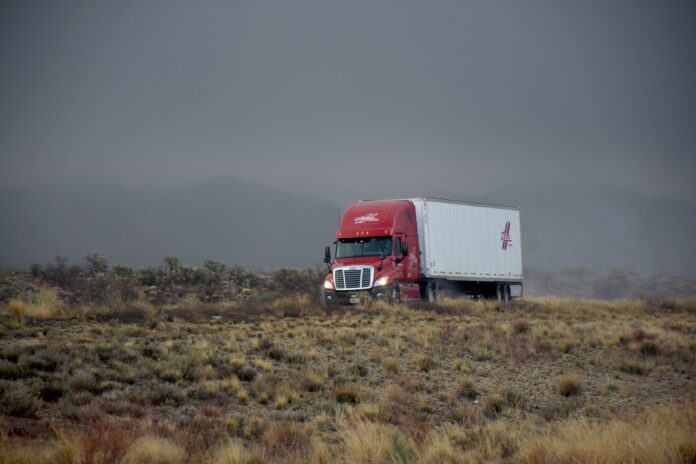Freight rates have risen sharply in 2021, boosting trucking profitability to attractive levels. According to DAT Flatbed Rates, nationwide spot rates are up about 30% in the last twelve months. This is one of the strongest increases on record. The economy is red hot and the trucking industry is constrained due to a driver shortage. Higher diesel and truck prices are additional factors causing the rating uplift.
Almost no one saw this strong rebound around the corner when the pandemic first hit at the beginning of 2020. In fact, many businesses and truckers were preparing for a prolonged recession. Instead, today we are experiencing one of the hottest markets on record and nothing looks like it will stop it.
Global Freight Trends Are Strong, With No End In Sight
The broader transportation industry is seeing similar trends – railways, shipping, and trucking are all experiencing strong demand and healthy rate increases. Container ships rates are now at all-time highs, and many shippers are finding it hard to secure cargo space on vessels due to lack of supply.
Congested maritime routes have led to shortages across a variety of industries. “The guy that supplies the tires that we use on our bicycles, earlier this year gave us a 10 to 12 month waiting period for new tires,” says Mr. Chaitowitz, of Up Cycles in an interview with the BBC. “It’s been stressful.”
About 70% of US freight travels by trucks according to data published by the Department of Transportation. Higher shipping and rail rates support higher trucking rates as customers look for other transportation modes – companies are forced to shift more of their volume to trucking when containers have zero capacity.
“I’m also expecting retail freight to remain robust as inventories are at historic lows. As retail stocks are rebuilt, it will boost freight. As has been the case for some time, trucking’s biggest challenges are not on the demand side, but the supply side, including difficulty, finding qualified drivers,” said ATA Chief Economist Bob Costello.
Higher New And Used Heavy-Duty Truck Prices Are A Result Of Supply Chain Issues
This summer most truck manufacturers including Peterbilt, Kenworth, Volvo, Freightliner, Mack, and International took extended downtime due to supply chain problems. The number one issue cited was a shortage of semiconductor chips, however, many other supply chain problems were present.
Truck manufacturers stated that their production schedule visibility was very low, and the future remains uncertain. New and used heavy-duty truck prices have risen as a result of reduced truck production and strong demand.
“So as has been discussed in recent months, industry truck production has been tempered by the under-supply of semiconductor chips. Kenworth, Peterbilt, and DAF had a good quarter and delivered 40,100 trucks with an additional 6,500 awaiting key components. While it’s very dynamic, we currently anticipate supplier constraints improving toward the end of this year,” said Paccar CEO Preston Feight. “Wish we could give you more clarity on how that semiconductor supply is going to proceed through the third and fourth quarter, but we just don’t have any more than that right now.”
“We assume that the worldwide shortage of semiconductor components supply will also affect our business in the second half of the year. We also recognized that the visibility [of] how the supply situation will actually develop further is currently low,” said Martin Daum, CEO of Daimler Trucks & Buses (Freightliner and Western Star).
In September many industry forecasters further cut their production estimates as supply chain issues persisted. The production outlook remains dim for the remainder of 2021 and early 2022 as component manufacturers indicate that they will not be able to catch up for a few quarters. The production cuts are occurring at the same time as net orders increase – as a result, manufacturer backlogs and wait times are expanding.
In addition to supplier constraints, Equipment Radar noted that higher commodity prices (such as steel and copper up strong double digits in the last year) will likely push truck production costs even higher. OOIDA’s 2020 owner-operator survey showed that the average cost of a new truck was about $140,000 ($60,000 for used trucks) last year.
Higher Profits Could Continue For Some Time
You are in good shape if you already have a truck and are active in the market today. Your truck cost is fixed while freight rates expand – this results in much higher profit margins. The rise in freight spot rates is much more than the overall expenditure increase for fuel and tires.
Many industries are competing for the same shrinking pool of workers given low unemployment. The trucking industry has raised incentives for new drivers including sign-on bonuses, improved truck cabs, free training, higher wages, and more. Despite these measures, carriers report that it is still difficult to find new drivers.
Between a driver shortage, economic boom, and truck production cuts, the profitability outlook for truckers today could continue for an extended term.









